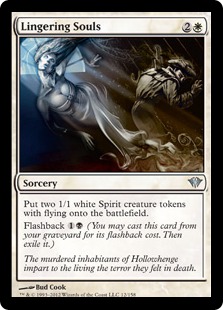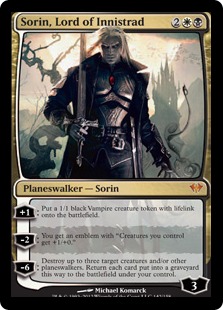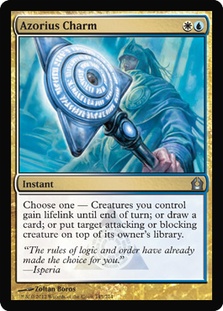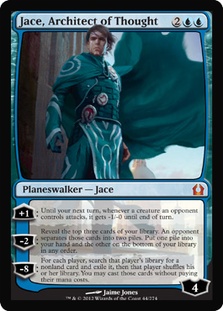I love new formats and post-rotation metagames. They’re ripe for a well-built control deck to swoop in for the kill.
In my last article, I posted a few raw decklists, but today we’ll take a look at the Virginia State Championship list that I piloted to first place a couple weeks ago.
Creatures (4)
Planeswalkers (7)
Lands (25)
Spells (24)

The metagame was as I expected here in Virginia with a lot of control, midrange green, Zombies, and Reanimator deck variants.
My MVP was Lingering Souls by a mile. I do not see myself piloting a control deck without Lingering Souls for a very long time. All day long I blocked to survive, killed planeswalkers and opponents, saved my own planeswalkers, and created card advantage through Forbidden Alchemy and Thought Scour. The card is super versatile and allows me to play a very limited amount of win conditions in the main and sideboard as I ride the coattails of my small flyers.
The deck overall has a good curve and a planeswalker armada that can hide behind the blockers Lingering Souls makes. Augur of Bolas into a turn 3 Lingering Souls creates a brick wall for any aggressive deck while we draw extra cards to set up for a big control finish.
Each card was useful and the list didn’t disappoint during the tournament, but a few of them did stand out more than the others.
Lingering Souls
I’ve already gone over the power level of the Spirit engine. The only other thing I would like to add is that almost everyone I’ve talked to still underestimates the card. I mean…why would anyone be afraid of a couple 1/1 flyers in a control deck? The best explanation I can give is that the engine is too hard to disrupt. Besides Curse of Death’s Hold, there is no simple answer to repeatable threat production.
Unlike the Walker decks of old, you shouldn’t burn the Souls now unless necessary. For example, if you are going to Supreme Verdict next turn, don’t waste a flashback to prevent six damage. Souls is for saving planeswalkers and racing; it shouldn’t be used to absorb damage. Use your life as a resource.
Sorin, Lord of Innistrad
With the popularity of Delver down and the majority of threats running around on the ground, Sorin was prime for a comeback. I always said he was an amazing planeswalker, and even in the older format he was still good, but now he is REALLY good. The emblem was epic for the States tournament as it allowed my flyers to become an instant two-turn clock or blockers that could clear a board with minimal cards used.
Making Vampires wasn’t too shabby either. These little guys can continuously apply pressure while ticking up to an ultimate that will scare any opponent. My control mirror opponents repeatedly laid down haymakers while I patiently accumulated card advantage.
I faced Thragtusk in every round aside from my two Delver opponents in the Swiss and my Grixis Control opponent in the finals. My friends and Twitter claimed he was not only a beast against aggro but also a house against control—not true. If your big finale is five power for five mana that leaves behind a dork, then you are doing it wrong in this format. Thragtusk is a good man and he does a lot for you in terms of bouncing back from a life and creature deficit…but against the control decks he’s not a ten out of ten.
Sorin is amazing against nearly every deck in the format, and once again I will tell you that he’s the planeswalker to use if you want to take your control deck to another level.
Azorius Charm
This card is everything I predicted it would be. The cycling ability lets you dump it off early against decks that will not be attacking you anytime soon. When a spell can cycle, its value jumps through the roof because in essence it will be never be a dead card. Against green decks, Zombies, Delver, and any other aggressive decks, this card will be one of your most powerful. It slows them down so much and at the same time takes away a draw step.
Snapcaster Mage can also get in the mix by flashing in, trading with something, and bouncing another creature—one of my favorite interactions during the tournament. It reminds me of the good old reactive control decks in a way.
I mentioned that the lifelink ability would be relevant once in a while, but I want to amend that statement. I lifelinked a Piked Spirit once, but it felt like overkill against Delver. It was simply win more. I have since cut one of the Charms from the main, but either way it will win you many matches.
Jace, Architect of Thought
Hmmm…he was 20 dollars when I picked up my set; now he’s 50. What happened?! Jace is as absurd as I theorized in nearly every matchup. I spent most of my last article on the planeswalker captain so I won’t repeat all those points, but I will give a few tips on proper Jace use.
One thing that I thought was obvious is to keep Jace alive at all costs. However, two opponents of mine thought it would be a good idea to draw some cards instead of upping Jace and put it at one loyalty. Don’t do that. Another mistake is to drop it to zero, draw some cards, then drop your last Jace in hand onto the battlefield. Unless you’re behind, don’t do it. It is tough to lose if you maintain an even board state with a planeswalker AND another in hand if they somehow deal with it. I understand doing it if you are holding nothing while your opponent is building an army, but if you have a grip and are dead even or ahead, just sit back and relax. Keep the backup Jace in case he gets dealt with.
Another tip about Jace is using him as target practice when the walls are crumbling around you. Multiple times against green midrange decks, I find myself facing down a small militia without a Wrath effect. While I could have used Lingering Souls to block or exile something with Sever the Bloodline, the right play is to drop Jace and minus two it. They will 100% slam into Jace to prevent you from Looting again into a Wrath effect and send the rest at you. This way you are much closer to an answer with that extra life buying you time.
Right before the event I upped my Jace count to three, and that was perfect. A few of my friends were running four and Memory Adept in the board, but I think that’s wrong. Three is the magic number for this deck.
The One-ofs!
Sever the Bloodline, Runechanter’s Pike, Ultimate Price, Sphinx’s Revelation, Terminus, Nephalia Drownyard, Vault of the Archangel
Each singleton in the deck did a great deal of work in winning matches in the ten-round tournament. My favorite one-of was definitely Runechanter’s Pike. When drawn later in the game, I usually won in a large attack or stabilized with a huge first striker.
I played against a Reanimator deck that played a bunch of Thragtusks with his Angel of Serenity. I chewed through his life total with seventeen-damage swings from a first strike flyer that eventually dropped him to a reasonable life total. The game took 45 minutes, and he was down to three cards in his library as I took the win for the match. He also brought out Griselbrand on turn 4, and I battled through his massive card-drawing engine with multiple Supreme Verdicts, removal spells, and Nephalia Drownyard. I put him in the odd situation of facing down lethal Pike damage while he was about to be decked. Even though getting a Griselbrand and infinite Angel of Serenity action going looks attractive, I feel that it may be cute rather than effective.
The Pike was so good for me that people boarded in artifact hate to prevent losing to it in games 2 and 3.
You have so much card draw and filtering in the deck that you don’t need more copies of the one-ofs in the maindeck. Cards like Sever the Bloodline and Terminus allowed me to deal with the more resilient creatures and provided me outs to certain situations that Supreme Verdict couldn’t get me out of. With Forbidden Alchemy, Thought Scour, Charms, Revelation, Tamiyo card draw and Jace’s digging ability, you will find the cards you need.
I condemned the Japanese strategy of running lots of singletons for the longest time, but in current Magic, it makes too much sense to avoid. While you need multiple Wraths and card draw spells, you can diversify your specific answers because of all your card selection.
The one-of lands provided additional win conditions and life gain later in the game. The control mirror is miserable according to most, but I love it. Since U/B is the least played of the control decks, I can take full advantage of Nephalia Drownyard. I Drowned out multiple opponents at the States tournament as well as in the SCG Invitational Qualifier I played in the next day. It defeated my opponent in the finals game 1 with the help of a topdecked Thought Scour; game 2 I had him Drowning as I boarded the other three in. It isn’t fun getting milled, but it’s a weapon that my opponents can’t counter or destroy. There are no Ghost Quarters or complete sets of Drownyards in anyone’s lists yet, so mill on.
The Vault of the Archangel puts you out of reach against control decks when you have an army of flyers with lifelink. It also allows your little dorks to kill much bigger dorks. The mana of this Esper deck is resilient enough that I don’t think it hurts the mana base to have two colorless lands, but be sure to not get too greedy with the maindeck.
Matchups
Control Mirror
The matchups for Esper are fantastic across the board. I spoke in great detail earlier about the power of Nephalia Drownyard in the control mirror, but let’s explore it a bit further. The strategy for the control players at States as well as in the SCG Open Series right now is to bring in Jace, Memory Adept. That is a huge mistake.
Control mirrors are won and lost by things that cannot be answered, and Memory Adept eats a two-mana Negate. You know your opponent is bringing in Negate… Why answer it with a five-drop?
If you’re playing U/B, then you should know that Drownyard is the most effective trump. If you don’t have access to Drownyard, then additional countermagic combined with early threats is another strategy to consider. Geist of Saint Traft is a beast against non-green control decks and dodges Negate very well. To be an effective Magic player, you have to create a sideboard strategy in mirror matches where you KNOW what your opponent is bringing in and plan accordingly. Simply having a bunch of planeswalkers in your board because they are generally good against control is a recipe for failure.
The control mirror is a grindy match that can last forever. We have Lingering Souls and better planeswalkers, but more often than not the game will go to decking. This could very well change after people get more creative, but at this point that is the reality. Make sure you are prepared for mill and have a strategy against it.
During the match, be sure to use Azorius Charms to cantrip early because they are fairly useless later in the game. Wrath effects and removal can be used generously early as well, but be sure to have an answer for a Niv-Mizzet or an army of Thragtusks if you fall behind. The most important card to save is Detention Sphere because eventually they will stick a planeswalker that you must kill. I will take a beating from a Nighthawk or attack a Jace in an attempt to preserve my one out for their bomb that’s coming in a few turns. It will pay off.
The control mirror is something I enjoy. It takes a lot of skill, timing, and thought. Plan your plays and strategy in advance and play swiftly to avoid time becoming your enemy.
Aggro / Midrange
Like any control deck, the shell of the Esper Walkers deck was built to deal with creatures in the early game. The Ultimate Price, Charms, Sever and Wrath affects did the trick against decks that play early drops and rush you for victory. Like previous control decks, you will follow up a sweeper with a planeswalker or a Drogskol Reaver and end the game in a few turns.
The only difference is we are running less of the haymakers than older decks, and we don’t have Consecrated Sphinx so sometimes the Lingering Souls take a while to knock them out. Augur of Bolas blocks the plethora of 2/1s early on and replaces himself with a spell that’s usually detrimental for your aggressive opponent. Forbidden Alchemy is also a surprising powerhouse compared to other card draw spells because of its ability to dig super deep for a sweeper and provide the late game advantage.
The strategy against Zombies isn’t very difficult and is about life management. Be sure to stay at a healthy life total and always leave a flyer or two behind to prevent the hasted Aristocrat from flying in for the kill.
Other aggro decks are a bit slower with big, doofy green creatures and accelerators that are begging to be Wrathed away. The scariest aggro deck is Jund, which is much more of a midrange deck. The Jund sideboard contains devastating discard spells, which prompts us to board in Negate. With a Negate and a Snapcaster, you should be safe due to their lack of card draw and be able to card advantage them out of the game. The biggest danger is tapping out and then untapping with no cards in hand… Play carefully against this deck post-board.
Lingering Souls is the most effective card against these strategies, just like in the old Standard format. In the early game, you have Spirit defense, and later you have an advantage from the graveyard. The sideboard is also very helpful against the aggro decks from Delver and Zombies to Jund and G/W.
I haven’t talked about Delver much yet. What happened to that deck?
What happened to Delver?
One of the scariest aggro decks in modern history has come and gone. Delver is Standard legal and still has a few of his boys like Geist of Saint Traft, Restoration Angel, and Runechanter’s Pike…but the loss of the Phyrexian cards and Ponder has been devastating. Before, they were able to Mana Leak every threat with Snapcaster and enough backup firepower to deal damage. Now, there are a lot of holes in that strategy.
I played against Delver twice during Virginia States. They flipped Delver on turn 1 and had Geist of Saint Traft looking me in the eye on turn 3. My only play was a Wrath effect that happened to be uncounterable. Where was this card when Delver was a deck?! I would have killed to have a guaranteed board sweep then, but I guess it’s better late than never.
I think Delver can still school midrange green decks and some control decks, but Lingering Souls is still their bane and Supreme Verdict is an ace in the hole at any point in the match. To top it all off, we are packing multiple Curse of Death’s Hold in the sideboard as a safety precaution. I remember long debates on Twitter and Facebook about how I was playing a losing strategy against Delver with my Walker Control decks of old. Despite a few SCG Invitational Top 8s, I still ended up sleeving Wizards up for my last SCG Invitational. Delver and Talrand are powerful, but control has entered a new age of domination at this point in time.
The Sideboard
Curse of Death’s Hold: Curse of Death’s Hold was a house against Zombies, Delver, and random Lingering Souls / mana dork Reanimator decks. The old technology is almost as good now as it was then. You’ll feel much safer with some Curses in your life.
Nephalia Drownyard: It’s all about alternative wins in the control mirrors. It was Luminarch Ascension years ago, and now it’s about milling them to nothingness. Don’t drop these from the board or your control matchup will get that much tougher.
Terminus, Ultimate Price, Sever the Bloodline: Adding more to the anti-aggro arsenal. It never hurts to take out some card draw, extra walkers, and expensive spells to kill more creatures. These sideboard cards are fairly self-explanatory.
Negate: This card is better than Mana Leak was in the previous format. Creatures are simply not scary, and Negate is only dead against Zombies and big green idiots in game 1. I bring in Negate against everything else to stop a critical Oblivion Ring, Rakdos’s Return, or Nicol Bolas. Bring it in and you’ll feel safer, trust me.
Sundering Growth: Good for obvious reasons AND YOU GET A SPIRIT!
Drogskol Reaver: No one sees it coming, no one can kill it, and if they can kill it, you Negate that spell and the game ends. This creature has the power to put a game away and is superb against aggro decks especially. I have moved him to the maindeck and one Azorius Charm to the board due to how amazing he was throughout Virginia States.
Conclusion
States was an amazing tournament, and I am very happy to be the two-time champ of Virginia. I’ve taken down a couple Two-Headed Giant States, but the Standard alternative always feels much better. I recommend this Esper Walkers deck to anyone playing in SCG Open Series: New Orleans or any competitive tournament. The power level ranks up there with U/B Control a couple years ago, and I think it will have tons of wins in the near future.
The deck can play out like a true control deck and an aggressive midrange deck with a Lingering Souls into a Sorin emblem. With how good control is and how good this deck happens to be, I wouldn’t be surprised if opponents start packing extra Curse of Death’s Holds, and if they do we can easily remedy the situation with a few more Sundering Growths and/or Detention Spheres.
Hope you enjoyed the article and the updates… Good luck friends!
Shaheen
@shaheenmtg – Twitter
[email protected] – Email




